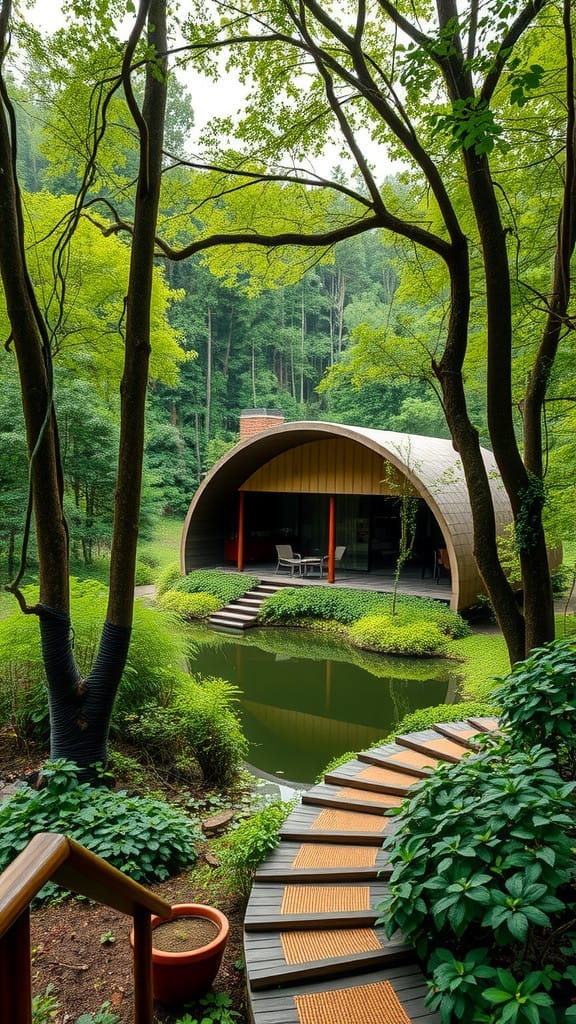Eco-Tourism? Urban Sustainability? Digital Nomad?

Hello, Off-Grid, Sustainability and ECO Living Enthusiasts! 🌿✨
As we near the close of another year, I want to express my heartfelt gratitude to each of you for being part of our inspiring community. Your commitment to embracing Off-Grid lifestyles and sustainable practices has turned this journey into an exciting adventure!
With the New Year just around the corner, let's carry that momentum forward. Whether you're perfecting your homesteading skills, finding innovative ways to live more sustainably, or diving into new projects, remember that every small step contributes to a larger change. Together, we have the power to make a real difference in our lives and the world around us.
Wishing you a New Year filled with fresh ideas, inspiring projects, and the fulfilment that comes from living in harmony with nature. Here’s to new beginnings and the endless possibilities that await us!
Happy New Year from all of us at the Off-Grid Cabin! 🎉🌲💚
Understanding Eco-Tourism: A Path Towards Sustainable Travel
Eco-tourism, a term that has gained significant traction in recent years, represents a form of sustainable travel that emphasizes environmental conservation, community engagement, and responsible tourism practices. As travellers increasingly seek meaningful experiences that connect them with nature and local cultures, eco-tourism offers a compelling alternative to traditional tourism models that often prioritize profit over preservation. This article explores the principles of eco-tourism, its benefits and challenges, and its potential to foster a more sustainable future for travel.
What is Eco-Tourism?
Eco-tourism is defined as environmentally responsible travel to natural areas, aimed at appreciating and conserving the environment while promoting the well-being of local communities. According to the International Ecotourism Society, it involves low-impact visitation that supports conservation efforts and provides socio-economic benefits to local populations. The core principles of eco-tourism include:
- Minimizing Environmental Impact: Eco-tourism seeks to reduce the ecological footprint of travel by promoting sustainable practices among tourists and operators.
- Supporting Local Communities: By prioritizing local economies and cultures, eco-tourism helps ensure that communities benefit from tourism.
- Environmental Education: Travelers are encouraged to learn about the ecosystems they visit and understand the importance of conservation.
The Benefits of Eco-Tourism
Eco-tourism offers a multitude of benefits for both travellers and local communities:
1. Environmental Conservation: Eco-tourism can play a crucial role in protecting natural habitats and biodiversity. By generating revenue for conservation efforts, eco-tourism can help fund initiatives aimed at preserving fragile ecosystems.
2. Economic Opportunities: Eco-tourism creates jobs and income opportunities for local residents. This includes employment in eco-lodges, guiding services, and local crafts. For instance, in Costa Rica, eco-tourism has led to the establishment of national parks that not only protect biodiversity but also stimulate local economies.
3. Cultural Exchange: Travelers engaging in eco-tourism often participate in cultural activities that promote understanding and appreciation of local customs and traditions. This fosters respect between visitors and host communities[2][6].
4. Awareness Raising: Eco-tourists typically gain insights into environmental issues such as climate change and wildlife conservation through guided tours or volunteer programs. This education can inspire travellers to advocate for sustainable practices long after their trip ends.
Challenges Facing Eco-Tourism
Despite its advantages, eco-tourism is not without challenges:
- Overtourism: Popular eco-tourist destinations can suffer from overcrowding, leading to environmental degradation and strain on local resources. The influx of tourists can disrupt wildlife habitats and diminish the very qualities that attract visitors in the first place.
- Greenwashing: (something we covered in a previous issue) Some businesses may falsely advertise themselves as eco-friendly without implementing genuinely sustainable practices. This "greenwashing" undermines the credibility of true eco-tourism initiatives.
- Community Displacement: In some cases, tourism development can lead to the displacement of local communities or exploitation of their resources. Ensuring that locals have a voice in tourism planning is crucial for equitable benefits.
The Future of Eco-Tourism
As awareness of environmental issues continues to grow, so does the demand for sustainable travel options. The eco-tourism sector is projected to expand at a rate of approximately 5% per year, particularly among millennial travellers who prioritize sustainability.
To ensure that eco-tourism fulfils its potential as a force for good, several strategies can be employed:
- Regulatory Frameworks: Governments should implement policies that promote sustainable tourism practices while protecting natural areas from over-exploitation.
- Community Engagement: Local communities must be actively involved in decision-making processes regarding tourism development to ensure their needs and rights are respected.
- Education and Awareness: Tourists should be encouraged to adopt responsible travel behaviours that minimize their impact on the environment.
Final Thoughts
Eco-tourism presents an opportunity for travellers to explore the world responsibly while contributing positively to environmental conservation and community well-being.
By embracing sustainable practices and supporting local economies, eco-tourists can help create a more equitable and environmentally friendly future for travel.
As this sector continues to evolve, it holds the promise of balancing enjoyment with responsibility—ensuring that future generations can experience the beauty of our planet while preserving it for years to come.
Citations:
https://www.gvi.co.uk/blog/smb-the-advantages-of-ecotourism/
The Reality of Becoming a Digital Nomad: Balancing Freedom and Challenges
So my fellow dreamers and wanderlusters! If you’ve found yourself scrolling through Instagram, admiring those picturesque beachside cafes with laptops perched on tables, or the serene mountain views where people are working away on their latest projects, you might have entertained the thought of becoming a digital nomad.
It sounds idyllic, right? The idea of sipping coffee by the ocean, working in your PJs, and exploring new countries at your leisure is appealing. But before you pack your bags and work on your tan while tackling a spreadsheet, let’s take a realistic look at the highs and lows of the digital nomad lifestyle. Grab a comfy chair, and a warm drink, and let’s dive in!
The Alluring Benefits of Being a Digital Nomad
Freedom and Flexibility: One of the most significant perks of being a digital nomad is the freedom to choose where you work. Maybe you enjoy the hustle and bustle of city life, or perhaps you prefer the tranquil sounds of nature. The choice is yours! Imagine opening your laptop on a sunny beach in Bali or a cosy café in Lisbon. It’s hard to argue with that level of flexibility.
Cultural Experiences: Living in different countries allows you to immerse yourself in various cultures, culinary delights, and local traditions. You’ll make friends from all walks of life and expand your horizons in ways that are truly enriching. Plus, let’s not forget the food! Tasting authentic cuisine directly from the source is an experience that goes beyond any restaurant meal.
Personal Growth: Traveling to new places forces you to step out of your comfort zone. You’ll encounter language barriers, navigate unfamiliar public transportation, and adapt to new environments. All of these experiences can foster incredible personal growth, making you a more resilient and adaptable individual.
Work-Life Balance: Many digital nomads find that their lifestyle helps them achieve a healthier work-life balance. The flexibility to create your own schedule means you can design your day around what works best for you, whether that’s working during your most productive hours and taking long breaks to explore local sights or using a more traditional 9 to 5 structure where it feels fitting.
Networking and Opportunities: As a digital nomad, you’ll often find yourself in co-working spaces where like-minded individuals congregate. This presents incredible networking opportunities that can lead to collaborations, new friendships, or even job offers. You never know who you might meet while working by the beach!
The Flip Side: Challenges of Digital Nomad Life
Isolation and Loneliness: While travelling can be thrilling, it can also sometimes be isolating. Living in new places away from family and friends can take a toll on your emotional well-being. For some, the freedom of exploring new environments can also lead to feelings of loneliness, especially if you’re moving frequently.
Unpredictable Income: Let’s be real: earning a steady income as a digital nomad can be a challenge. Freelancing gigs and remote jobs can sometimes be unpredictable, leaving you in financial limbo. It's essential to have a financial cushion or a backup plan to ride out the lean months.
Distractions Galore: It’s easy to get distracted when there’s so much to see and do! The temptation to explore every nook and cranny of a new city can lead to productivity slips. Finding a work-life balance becomes crucial—after all, that’s why you’ve chosen this lifestyle, right?
Visa and Legal Issues: Each country has its own regulations regarding work permits and visas, and navigating these can feel like a minefield. Forgetting to properly sort these out could lead to uncomfortable conversations with border control or unexpected travel disruptions.
Lack of Stability: While spontaneity can be exhilarating, it can also be tiring. Constantly packing and unpacking your life into suitcases could wear you down over time. A lack of stability can affect your routine and mental health, making it essential to carve out familiar practices even in unfamiliar spaces.
Tips for an Easier Transition
Now that we’ve explored both sides of the digital nomad lifestyle, let’s look at some practical tips for making the transition a bit smoother:
Establish a Routine: Even with the freedom of the digital nomad lifestyle, having a daily routine can help provide structure. Whether it’s setting work hours or time for exercise, routines can ground you amidst the chaos of travel.
Invest in a Quality Wi-Fi Connection: A reliable internet connection is crucial for remote work, before committing to a new location, research cafes, co-working spaces, and accommodations that offer solid Wi-Fi. This can make or break your work experience!
Stay Connected: Technology makes staying in touch with loved ones easier than ever! Regular video calls, texts, or even sharing travel experiences on social media can help combat loneliness.
Prioritise Wellness: Adventure is fabulous, but remember to prioritise self-care. Make time for rest, healthy meals, and activities that fill your cup. Whether that’s yoga, reading, or exploring local parks, don’t underestimate the value of taking care of yourself.
Embrace the Journey: Finally, stay open to the adventures ahead! Some of the best memories come from unexpected situations, so embrace the surprises. After all, the digital nomad lifestyle is about more than just work—it's about living life to the fullest!
Final Thoughts: Chart Your Own Path
So there you have it—the reality of becoming a digital nomad! It’s a lifestyle filled with excitement, freedom, and opportunities for growth, but it also comes with its own set of challenges. As you weigh the pros and cons, remember that everyone’s experience will be unique.
If the idea of travelling while working resonates with you, take a leap of faith! Embrace the adventure and all the incredible experiences that come with it. After all, life is too short to spend it sitting in one place—let's explore every corner of this beautiful world together! Safe travels, and happy “nomading”! 🌍✈️💻
Urban Sustainability: Forging a Greener Path in the Concrete Jungle
We find ourselves in urban areas that are bustling with life and thriving communities, the quest for sustainability has shifted from the rural countryside to the heart of the city. With over half of the world's population now residing in urban environments, it’s crucial to explore how we can harmoniously combine city living with sustainable practices. Whether you’re a city dweller or just fascinated by the impact we can make on our environment, let’s dive into the exciting world of urban sustainability and discover how we can achieve a greener lifestyle even amidst the concrete jungle!
Understanding Urban Sustainability
Before we roll up our sleeves and get into the nitty-gritty, let’s clarify what urban sustainability actually means. In a nutshell, it refers to creating and maintaining urban environments that can support the well-being of people and the planet alike. This encompasses various aspects, including ecological balance, efficient resource use, social equity, and economic viability.
Essentially, it’s about living in a way that meets our current needs without compromising the ability of future generations to meet theirs. Now, let’s break that down into actionable steps that you can incorporate into your urban life!
1. Embrace Public Transportation (or Your Own Two Feet!)
One of the easiest ways to promote sustainability in urban areas is to ditch those gas-guzzling vehicles and embrace the power of public transportation. Trains, buses, trams — all of these options reduce traffic congestion and lower greenhouse gas emissions. Plus, think of all the epic people-watching opportunities you’ll have while riding the subway!
If public transport isn’t your speed, consider cycling or walking for shorter distances. Not only will you decrease your carbon footprint, but you’ll also enjoy the added health benefits of exercise. Who knew sustainability could be a workout too? 🚴♂️
2. Go Green at Home
Don’t let urban living cramp your eco-friendly style! Small changes at home can create significant impacts. Consider the following:
Energy Efficiency: Replace incandescent bulbs with energy-efficient LED lights. Opt for appliances with the ENERGY STAR label. These changes will save both energy and money. It’s like giving a high-five to the planet… and your bank account!
Smart Thermostats: Install a smart thermostat that adjusts heating and cooling based on your lifestyle. No more heating the entire house while you’re out gallivanting in the city!
Water Conservation: Install low-flow showerheads and faucets to conserve water without sacrificing comfort. And remember, every little bit helps — turning off the tap while brushing your teeth is a simple habit that can save gallons!
3. Grow Your Own Food
Urban gardening is on the rise, and for good reason! Growing your food not only reduces your carbon footprint but also reconnects you with nature. Here’s how to get started, even in small spaces:
Container Gardening: Limited space? No problem! Plant herbs, vegetables, or flowers in pots on your balcony or windowsill. Just make sure they get enough sunlight to thrive.
Community Gardens: Many urban areas have community gardens where you can join fellow gardeners to share resources and knowledge. It’s a fantastic way to meet people in your neighbourhood while digging your hands into the earth!
Vertical Gardens: If you’re feeling particularly adventurous, consider a vertical garden. By utilising wall space, you can grow plants upward rather than outward, perfect for apartment living!
4. Embrace Local and Sustainable Businesses
Support local businesses that prioritize sustainable practices. When you choose to shop locally, you’re not only keeping money in the community but also reducing emissions from transportation. Here’s how you can do it:
Farmers’ Markets: Spend your Saturdays exploring local farmers’ markets, where you can find fresh, seasonal produce without the packaging horrors of big supermarkets. Plus, you get to chat with vendors about how they grow their goods—and maybe get some pro tips!
Eco-friendly Shops: Seek out shops that sell products made from sustainable materials. Whether it’s clothing, homeware, or personal care items, supporting these businesses encourages greener practices in the marketplace.
5. Reduce, Reuse, and Recycle
The mantra of sustainability is as important in urban areas as anywhere else. However, in cities, waste disposal can be even more challenging, so let’s turn it into a way of life:
Mindful Consumption: Before making a purchase, ask yourself: "Do I really need this?" Less consumption means less waste, which is the cornerstone of sustainability.
Creative Reuse: Use your imagination to repurpose items before tossing them out. Old jars can become storage containers, and pallets can be transformed into garden furniture. Check out DIY projects that turn your trash into treasures!
Effective Recycling: Familiarize yourself with your local recycling rules. Many cities offer curbside recycling, but knowing which items are accepted can help reduce contamination and improve the recycling rate in your community.
6. Advocate for Change
Finally, make your voice heard! Advocate for sustainable policies in your local government and community. Attend town hall meetings, participate in civic discussions, and encourage your neighbours to join you. When communities band together, they can drive significant systemic changes.
It may feel like a small effort, but every whisper of encouragement for green initiatives adds up. Change often begins with one passionate voice — why not make it yours?
Final Thoughts: Urban Sustainability Is Within Reach
Becoming a sustainable urban dweller isn’t as daunting as it seems. With small shifts in mindset and action, you can create a thriving, eco-friendly lifestyle in the heart of the city. Embrace the joy of contributing to a healthier planet while enjoying everything these vibrant urban environments have to offer.
So, whether it’s lugging groceries from a local market on foot, planting herbs in your balcony pots, or advocating for greener policies, remember: your actions matter. Urban sustainability is about connectedness — to nature, to your community, and to a vision of a brighter future for our planet. Let’s get to work and make our cities more sustainable, one green initiative at a time! 🌱🏙️✨

As we wrap up this edition of the Off-Grid Cabin newsletter, we’d love to hear from you! Your experiences, hints, and tips are invaluable to our community. Whether you’ve recently tried a new sustainable practice, discovered a fantastic resource, or have a tried-and-true method for living Off-Grid, please share your insights with us!
We encourage you to hit the button below and join the conversation! Your ideas could inspire fellow readers and make a positive impact on someone’s journey toward a more sustainable lifestyle.
And if you enjoyed this newsletter, don’t keep it to yourself! Share it with friends, family, or anyone interested in embracing an Off-Grid lifestyle. Let’s spread the knowledge and empower others to join us in this amazing adventure!
Thank you for being a part of our community, and we can’t wait to hear from you! Happy living Off-Grid! 🌿✨
PLEASE SHARE THIS NEWSLETTER FAR AND WIDE,
I intend to keep the subscription fully FREE for as long as possible!
Join me as a supporter and member with a real-life couple off-grid in Sweden:
Some more of my scribbles (ALL FREE):












